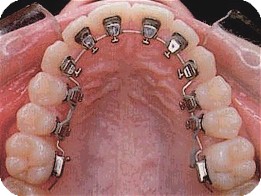Lingual braces are ideal for those who want the effects of braces, but are apprehensive about showing a mouthful of orthodontic work to the world.
Gaps, overlaps, crowding, rotated teeth—these are just some of the things your teeth can do to ruin your smile. Fortunately, these are all conditions curable by orthodontic appliances, or braces. Braces are metal, plastic or ceramic devices that put tension on your teeth to shift them into a more desirable position. Braces can also correct maloccusion, or bad bites. Braces worn in conjunction with headgear can level an overbite (when your top jaw is larger than your lower jaw) or an underbite (when your lower jaw is larger than your top jaw).
Traditionally, braces have consisted of metal brackets and wires. However, some people have feared the idea of a "metal mouth" so much that they refuse to wear braces altogether, missing out on the possibility of a beautiful smile. For this reason, orthodontic research began to focus on less visible options. This is how lingual braces came to be. Though similar in function to traditional braces, lingual braces sit on the back of your teeth—making them completely invisible from the front. Lingual braces are an ideal option for adult orthodontic patients.
Unlike standard brackets, which are mass-produced, lingual braces require a custom-made bracket for each tooth. For this reason, your orthodontist's first step is to create a mold of your teeth. Brackets are made based on this mold, then set in wax and placed in a small plastic applicator. This applicator ensures that the brackets remain aligned, as they will be pressed into place, not individually cemented. When the time for application comes, your orthodontist applies cement to the back of each bracket and press the entire set into place. Once the cement sets, the orthodonist breaks the applicator off. The brackets remain in place. Finally, your orthodontist installs an arch wire on the back of your teeth. This wire is shaped in the ideal position of your teeth. Once it has been threaded through the brackets, the wire tries to shift back into its original position, pulling your teeth into place as it does so.
Lingual braces can be worn on the top and bottom teeth. Because the bottom teeth are generally less visible anyway, a popular combination is to have lingual braces on the top teeth and clear (ceramic or sapphire) braces on the bottom.
Like any braces, lingual braces take some getting used to. The back of your top teeth will not meet up with your bottom teeth at first. Also, expect "tongue problems," like lisping, for the first one to four weeks of treatment. The first couple of weeks may require learning some new swallowing techniques, as "tongue thrusts" might not be possible. You may also want to practice eating in front of a mirror at home. Like all braces, lingual braces pose the threat of food caught in the brackets or wires. The danger with lingual braces is that you yourself might not notice it. There is little point investing time and money into invisible braces only to have someone else inform you of a string of lettuce dangling mysteriously from the back of your teeth.
In addition to the potentially lengthy adjustment period—longer and more difficult than that of traditional braces, according to some orthodontists—lingual braces have a few other cons. Not all orthodontists are trained in the application of lingual braces, so finding one may take some shopping around. As well, because they are custom made and require special training for the orthodontist, lingual braces are more expensive than traditional braces.
相关阅读:
 发表评论
发表评论 用户评论
用户评论
